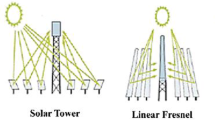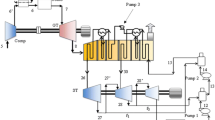Thermodynamic efficiency indicators of equipment for alternating cyclic steam and flue gas injection to increase oil recovery and reduce adverse environmental impact were analyzed applied to Colombian heavy oils production. The equipment consisted of two subsystems: steam generation and flue gas compression. The energy carrier parameters were chosen based on the depth of the producing wells and the experimental data provided by the Colombian partner. The thermodynamic analysis involved estimation of exergy losses of the subsystems operating both separately and jointly to ensure alternating cyclic steam and flue gas injection. Various steam to flue gas injection ratios were examined over a five-day cycle. It was found that the efficiency of integrated subsystems, which is determined by minimum total exergy losses, differs drastically, depending on whether centrally or locally generated electric power is used. It was concluded that, in addition to the thermodynamic analysis, it is essential to conduct an economic analysis of the variable part of the reduced costs for implementation of the alternating cyclic steam and flue gas injection process. Economic calculations showed that the optimum technological solution would be use steam and flue gas injection ratios of 4.5:0.5 in a 5-day cycle as well as a centrally generated power supply source is used.




Similar content being viewed by others
References
M. E. Austin-Adigio, Enhancing Steam-Assisted Gravity Drainage Applications in Challenging and Non-Challenging Oil Sands Reservoirs, Calgary, Alberta (2018), p. 227.
F. M. Nasab, H. Shahandeh, and Z. Li, Ind. Eng. Chem. Res., 57, No. 29, 9513-9526 (2018).
О. Ashrafi, Ph. Navarri, and O. Zamor, Chemical Engineering Transactions,74, 835-840 (2019).
M. V. Kok, Y. Yildirim, and S. Akin, Energy Sources. Part. A, Utilisation and Enviromental Effects, 31, No. 5, 377-386 (2009).
A. E. Bayat, R. Junin, R. Kharrat, et al., International Journal of Oil, Gas and Coal Technology, 9, No. 4, 394-421 (2015).
H. Liu, H. Wang, H. Xiong, et al., Energy & Fuels, 34 (5), 5777-5787 (2020)
S. Gupta, S. Gittins, and P. Picherack, J. Can. Pet. Technol., 44, No. 11, 8-13 (2005).
Davi M. S. de B. Lima, A. Araujo Edson, et al., Computer Aided Chemical Engineering, 38, H, 1743-1748 (2016).
Russian Federation Patent No. 2338060.
Russian Federation Patent No. 2597039.
J. Szargut and R. Patel, Exergy [Russian translation from English], Energiya, Мoscow (1968), p. 288.
V. M. Brodyanskii and N. B. Kalinin, Inzhenerno-Fiz. Zh., 10, No. 5, 596-599 (1966).
V. M. Brodyanskii, W. Fratzscher, and K. Mikhalek, Exergy Method and Its Application [in Russian], Khimiya, Moscow (1988), p. 279.
H. D. Baehr, Technische Thermodynamik, Springer-Verlag, Berlin (1965), p. 242.
L. Goldstein, B. Hedman, D. Knowles, et al., Gas-Fired Distributed Energy Resource Technology Characterizations. Report of National Renewable Energy Laboratory, 2003, p. 226.
The work was conducted with the financial support for research from the Ministry of Science and Higher Education of the Russian Federation within the ambit of Research and Development in Priority Areas of Development of Scientific-Technical Complex of Russia for 2014-2020 (Project No. 14.583.21.0064, Unique Project Identifier RFMEFI58317X0064).
Author information
Authors and Affiliations
Corresponding author
Additional information
Translated from Khimiya i Tekhnologiya Topliv i Masel, No. 6, pp. 51–56, November – December, 2021.
Rights and permissions
About this article
Cite this article
Naletov, V.A., Glebov, M.B., Naletov, A.Y. et al. Thermodynamic Analysis of Alternating Cyclic Steam and Flue Gas Injection for Colombian Heavy Oils. Chem Technol Fuels Oils 57, 926–932 (2022). https://doi.org/10.1007/s10553-022-01330-6
Published:
Issue Date:
DOI: https://doi.org/10.1007/s10553-022-01330-6




